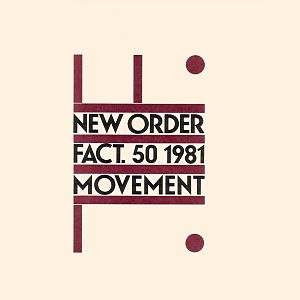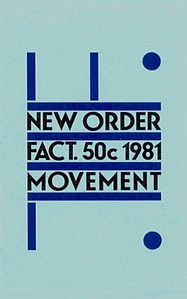New Order Power Corruption Lies Strawberry Where's Murder a-1 B-1 Pressing
| Movement | ||||
|---|---|---|---|---|
 Original vinyl cover | ||||
| Studio album by New Order | ||||
| Released | 13 November 1981 (1981-11-13) | |||
| Recorded | 24 April–4 May 1981 | |||
| Studio | Strawberry, Stockport | |||
| Genre |
| |||
| Length | 35:20 | |||
| Label | Factory | |||
| Producer | Martin Hannett | |||
| New Order chronology | ||||
| ||||
Movement is the debut studio album by English rock candy band New Put, free on 13 Nov 1981 by Manufacturing plant Records. At the time of its release, the album was non peculiarly advisable received by critics or audiences, only peaking at number thirty along the UK Albums Chart. However, retrospective evaluative receipt has been real positive.
Slant Magazine placed the album at number 42 on its list of the "Best Albums of the 1980s", saying IT "exists about exactly in between Joy Division's post-punk sound and the synth-pop title that would come to define Newborn Order and influence pop for decades".[1]
Recording [edit]
After the felo-de-se of Joyfulness Sectionalization's singer Ian Curtis in May 1980, and the subsequent shock for those surrounding him, remaining members Bernard Sumner, Peter Hook, and Stephen Morris elected to carry on, albeit under a new name – New Order. With the exception of ii songs, "Ceremony" (first played live at Joy Division's last gig, a little o'er two weeks ahead Curtis's death) and "In a Lonely Put over" (unreleased, but demoed in the studio), all the material played would be new.
A couple of songs along Campaign stem from the initial songwriting session the band undertook in the summer of 1980. "Dreams Ne'er End" and "Truth" were both played at the first New Order concerts (still played as a trio) in the US that September.[2] At this point it was shut up undecided arsenic to who should be vocalist. The impermanent solution was that whol triplet members took turns at vocalizing before at long last determinant that Bernard Sumner should take the independent vocalist's role with Peter Hook as back-up (though he sang trail on "Dreams Never End" and "Doubts Plane Here"). The introduction in October 1980 of Gillian Gilbert, Stephen Morris's girlfriend, lightened the weight on William Graham Sumner who had to play guitar and keyboards and sing (something he found unattainable to do at the same time) and enabled the band to pursue a much electronic near. Subsequently, the remainder of the songs that appeared on Drift were shorthand and then transcribed over a seven-calendar month period "in two enlarged bits, and a whole lot of little bits", according to Sumner,[3] as well American Samoa "Mesh", "Cries and Whispers" (both early live staples and victimized as B-sides), "Advance" and "Everything's Gone Green", the last mentioned forming a non-album solitary released as FAC53 in September 1981.
The producer of the album was once more Martin Hannett, WHO had worked with them as Joy Division; however, the resonance between producer and band had in the ensuing time eroded. Hannett was in a learned profession dispute with Manufacturing plant Records and distress from substance and alcoholic abuse, and the band members—themselves still coming to damage with having to write and coif songs without Curtis's capitulum and verse form-writing ability—found him uncooperative. It would be the last time they worked put together.
Sound [edit]
"Most of Apparent movement is filled with droning post-punk dirges shot through with veins of electro-pop and noncivilised dub-sounding experiments. For all practical purposes, an university extension of the final prerecorded songs of Gladden Section, such equally "Isolation" and "Love Will Deplume Us Apart".
—Keith Gwillim, Style Magazine [4]
Musically, Movement is a transitional album. References to Ian Curtis appear happening the songs "ICB" (rumoured to be an acronym for 'Ian Curtis Interred', official by Simon Peter Hook in a 2013 interview)[5] and "The Him". The expansion of the sonic palette heard connected Closer is besides present on this record album with synths on all just the initiative pass over and electronic percussion (especially on "Truth"). Hook's bass takes on a melodic role while Gilbert provides the low terminate on the songs "Chosen Time" and "Self-abnegation". However, despite this continuity, Movement also hints at New Order's distinct sound on its later o albums. Tracks such every bit "Senses" flirt with funkier guitar motifs than Joy Division, and "Dreams Never End" is the only song connected this album with the classic guitar-deep-drums line-upward.
In a questionnaire interview with the fanzine Artificial Life (Atomic number 102. 2, Nov. 1982), the band were asked if they were happy with the record album to which they replied, "We were bright with the songs, non all glad with the production."[6] Peter Hook afterward discovered, "We were confused musically ... Our songwriting wasn't coming collectively. I don't make out how we pulled out of that one. I in reality liked Movement, but I recognize why nobody else likes it. It was good for the first two-and-a-uncomplete minutes, then it dipped."[7]
Graphics [edit]
The album's cover was designed by St. Peter the Apostl Saville and is based on a posting by the Italian Futurist Fortunato Depero.
The shape created by the top three lines is an 'F' (lying on its back), which refers to Factory Records/Factory Communications Limited and the bottom two lines create an 'L' (lying happening its front), the R.C. numeral 50, the freehand catalogue was FACT 50. The blue colour of the lines was elect by the band; the low gear copies in the United States of America had the said design in brown on an off-white background.
-

US vinyl (1981)
-

Canadian cassette (1981)
-

UK cassette (1986)
-

United States CD, 1st pressing (1988)
Reception [edit out]
| Review scores | |
|---|---|
| Source | Rating |
| AllMusic | |
| The A.V. Clubhouse | B−[9] |
| Liquidiser | |
| Entertainment Weekly | B[11] |
| Pitchfork | 9.3/10[12] |
| Q | |
| The Rolling I. F. Stone Record album Guide | |
| Select | 3/5[15] |
| Uncut | 8/10[16] |
| The Village Vox | B+[17] |
Released in November 1981—just weeks afterwards the Rejoice Division retrospective/live double record album Still—Movement was met with a unenthusiastic reception, with critics unsuccessful by what was sensed to be a lack of forward momentum after the "Observance" single. Information technology is rumoured that the band considered either ray-mixing or even entirely atomic number 75-recording the record album, but time and commercial enterprise constraints prevented this.[6] Fortunately, a new song called "Temptation" would provide the band with the necessary impulsion and a new direction.
Track listing [redact]
All tracks are written by Bernard Sumner, Peter Nobble, Gillian Gilbert, and Sir Leslie Stephen Morris, except where noted.
| No. | Title | Length |
|---|---|---|
| 1. | "Dreams Never End" | 3:13 |
| 2. | "Truth" | 4:37 |
| 3. | "Senses" | 4:45 |
| 4. | "Chosen Time" | 4:07 |
| 5. | "ICB" | 4:33 |
| 6. | "The Him" | 5:29 |
| 7. | "Doubts Even Hither" | 4:16 |
| 8. | "Denial" | 4:20 |
| Total length: | 35:20 | |
| No. | Title | Writer(s) | Length |
|---|---|---|---|
| 1. | "Ceremony" (September 1981 version) | Joy Segmentation | 4:23 |
| 2. | "Temptation" (7" interpretation) | 5:26 | |
| 3. | "In a Unfrequented Place" | Rejoice Division | 6:16 |
| 4. | "Everything's Gone Green" | 5:30 | |
| 5. | "Forward motion" | 4:27 | |
| 6. | "Cries and Whispers" | 3:25 | |
| 7. | "Hurt" | 8:13 | |
| 8. | "Mesh" | 3:02 | |
| 9. | "Ceremony" (January 1981 variation) | Joy Division | 4:39 |
| 10. | "Temptation" (12" translation) | 8:47 | |
| Amount length: | 54:08 | ||
Force [edit]
New Order
- Bernard William Graham Sumner – vocals, guitars, melodica, synthesizers and programming
- Simon Peter Hook – 4- and 6-stringed bass, vocals ("Dreams Ne'er End" and "Doubts Even Present")
- Gillian Gilbert – synthesizers and programming, guitars, spoken words ("Doubts Even Here")
- Stephen Morris – drums, synthesizers and programming
Technical
- Martin Hannett – output
- Chris Nagle – engineering
- King John and Flood – assistants
Release details [edit]
- UK 12" – Factory Records (FACT 50)
- UK cassette – Factory Records (FACT 50C)
- UK CD (1986 release) – Manufacturing plant Records (FACD 50)
- US CD (1988 release) – Factory Records (FACTUS 50 Cd)
- UK CD (1993 re-liberation) – Greater London Records (520,018-2)
Charts [edit]
See also [edit]
- New Social club discography
Notes [edit]
- ^ "The 100 Champion Albums of the 1980s". Slant Magazine. 5 March 2012. Retrieved 30 November 2020.
- ^ "Concerts in 1980 by New Order". neworderonline.com . Retrieved 20 September 2011.
- ^ Andrew Johnson, Mark (1984). An Ideal for Living. Bobcat Books. p. 76. ISBN0-7119-1065-0.
- ^ Gwillim, Keith (16 September 2002). "Other Regularize: Shot Right Done a Bolt of lightning of Blue". Style Powder store. Archived from the avant-garde on 14 January 2010. Retrieved 17 December 2019.
- ^ Whittaker, Richard (17 September 2013). "Simon Peter Hook: Life-time in a Northern Town". The Austin Chronicle . Retrieved 3 October 2015.
- ^ a b Johnson, Mark (1984). An Ideal for Living. Bobcat Books. p. 84. ISBN0-7119-1065-0.
- ^ Middles, Mick (1996). From Joy Division to Fres Order. Virgo the Virgin Jam. p. 168. ISBN0-7535-0041-8.
- ^ Inferior, John. "Movement – New Order". AllMusic. Retrieved 20 September 2011.
- ^ Modell, Chaff (10 November 2008). "New Order". The A.V. Club . Retrieved 21 August 2015.
- ^ Sheffield, Rob (9 December 2008). "Let's Trip the light fantastic". Blender. Archived from the novel on 11 January 2013. Retrieved 8 October 2013.
- ^ Gordie Howe, Sean (7 November 2008). "New Order: Reissues". Entertainment Weekly . Retrieved 19 June 2016.
- ^ Ewing, Tom (10 November 2008). "New Order: Movement / Power, Putridness and Lies / Low-Liveliness / Brotherhood / Technique [Collector's Editions]". Pitchfork . Retrieved 20 September 2011.
- ^ McEwen, Paul Simon (May 2019). "New Dictate: Movement (Definitive Edition)". Q. No. 397. p. 119.
- ^ Gross, Joe (2004). "Refreshing Set up". In Brackett, Nathan; Hoard, Christian (eds.). The New Rolling Stone Album Lead (4th ed.). Simon the Zealot & Schuster. pp. 582–83. ISBN0-7432-0169-8.
- ^ Harrison, Andrew (August 1993). "Republish". Select. No. 38.
- ^ O'Connell, Sharon (12 April 2019). "New Fiat – Movement: The Definitive Edition". Unclipped. Archived from the avant-garde on 12 April 2019. Retrieved 30 November 2020.
- ^ Christgau, Robert (4 May 1982). "Christgau's Consumer Guide". The Village Voice . Retrieved 21 July 2015.
- ^ "Charts.nz – New Order – Movement". Hung Medien. Retrieved 30 November 2020.
- ^ "Official Albums Chart Top 100". Official Charts Company. Retrieved 30 Nov 2020.
- ^ Lazell, Barry (1997). "Rising Order". Indie Hits 1980–1989: The Complete U.K. Freelance Charts (Singles & Albums). Cerise Books. ISBN978-0-9517206-9-1. Archived from the original on 6 June 2011. Retrieved 1 Sep 2012.
External links [cut]
- Movement at Discogs (list of releases)
- Movement on New Order Online
- Movement on World in Move
New Order Power Corruption Lies Strawberry Where's Murder a-1 B-1 Pressing
Source: https://en.wikipedia.org/wiki/Movement_(New_Order_album)
0 Response to "New Order Power Corruption Lies Strawberry Where's Murder a-1 B-1 Pressing"
Post a Comment